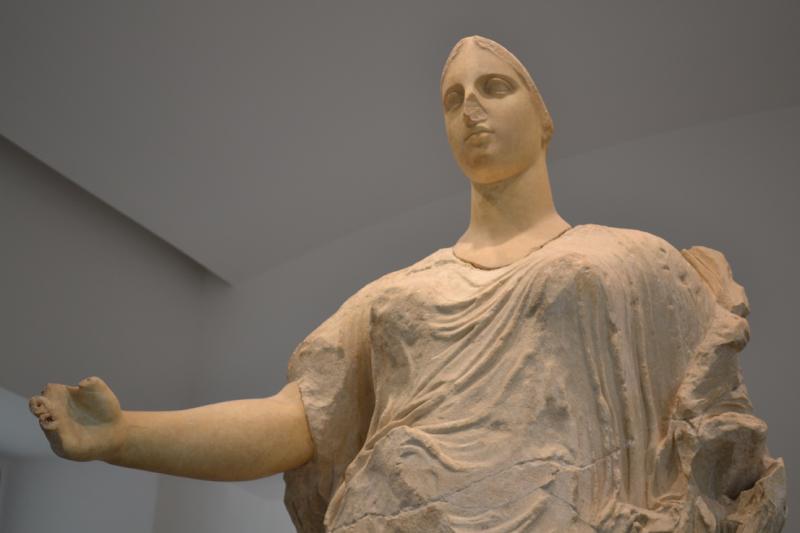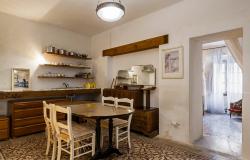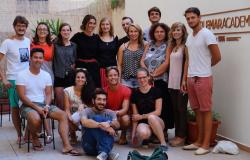We feel very honored that our readers are choosing to share their heritage travel stories with us, and we continue our ‘Back to Your Italian Roots’ series today with the wonderful story of Gina Sconza, an Italian-American from Oakland, CA.
Gina Sconza was inspired to seek out her roots after seeing an image of the Goddess of Morgantina statue displayed on the cover of the Smithsonian magazine, commemorating its repatriation to Sicily in 2011. “Seeing that image drew out a deep longing in me to return to the island of my maternal ancestors, to visit the Goddess where she now stands, magnificently repatriated in Aidone, and to trace her roots among the ruins of Morgantina,” Gina recounted in our first email correspondence.
[As reported in the Smithsonian article, the Goddess of Morgantina, a 2,400-year-old statue of a woman once believed to be Aphrodite, the Greek goddess of love, was the centerpiece of the Greek and Roman antiquities collection at the J. Paul Getty Museum near Malibu, California. Experts now believe the statue represents Persephone, not Aphrodite; since 2011, it’s been on display in a small museum in Aidone (Enna), near the archeological site of Morgantina, where the statue originally came from.]
 [Photo: Gina Sconza's grandparents circa 1920.]
[Photo: Gina Sconza's grandparents circa 1920.]
In 2012, Gina traveled to Sicily, where she not only paid homage to the Goddess, she also visited her grandmother’s hometown of Misilmeri (Palermo), a visit that enabled her to find the family documents she had been seeking and relatives that she and the Sicilian-American branch of her family had lost contact with since after WWII.
Formerly a professor of Romance Languages and Literatures, and now a freelancer teaching Spanish and Italian, Gina hopes to secure her Italian citizenship, spend more time in Sicily, and master the Sicilian language.
Read the interview with Gina below.
What prompted you to begin your search to trace your Italian roots?
My father Vincenzo was born in Calabria and emigrated to the U.S. in 1922 at the age of 18. He spoke only Italian at home and kept our Italian heritage very much alive, so I know that side of my family history quite well. Growing up, I felt less connected to my Sicilian roots on my maternal side, in part because my Italian American mother chose to speak English at home rather than Italian. I visited Sicily once as a child, but never reached my grandparents’ hometown of Misilmeri (Palermo). Then in 2011, I happened upon an image of the Goddess of Morgantina on the cover of the Smithsonian Magazine, and I immediately felt drawn to return to Sicily to search for my maternal lineage. The story of the Goddess’s repatriation to Sicily from the Getty Museum in California moved me to reconnect with the land of my Sicilian ancestors as a personal act of repatriation.
Please describe the process. Did you already know your ancestral town? If not, how did you find it? Who or what was your first resource when you started your search for your ancestral town and Italian relatives?
I knew that my maternal grandparents had emigrated to the U.S. from Misilmeri (Palermo), Sicily, in 1911, the year before my mother was born in Chicago. When I visited Misilmeri in 2012, I carried with me the family tree my brother Jim, our family historian, had compiled using information gleaned from our U.S. relatives and from my mother’s 1956 visit to Misilmeri, but I had little else to go on. I wanted to walk the streets of Misilmeri to get a feel for the city, then visit the records office at the Comune (city hall) in the hopes of finding more information about our family.
 [Photo: Gina Sconza with her cousin Franco just after they met, both overcome with emotion, as Gina recounted.]
[Photo: Gina Sconza with her cousin Franco just after they met, both overcome with emotion, as Gina recounted.]
What were the obstacles, if any, during the process of finding your relatives and then getting in touch?
When I visited my grandparents’ Comune in Misilmeri, the task of finding my relatives unfolded in a way I never expected. In the records office I requested all the documents pertinent to my grandparents, and, as I read each document, I was incredibly moved. Seeing the astounding effect of an archival document, Signora Borgese, the head of the records office, became a sort of fairy godmother, bringing me everything she could find that might be pertinent. As I pored over this rich documentary trove, Signora Borgese’s ears perked up at my offhand comment about having relatives in Torre del Greco (Naples), and she picked up the phone. She recalled having heard one of her colleagues mention that he had relatives in Torre del Greco and the wheels were turning. When her colleague answered the phone, she said, “Franco, c’è un’americana qui che cerca i parenti,” (Franco, there's an American here looking for her relatives) and she wondered aloud if we might be related. So the plot quickly thickened, and thanks to Signora Borgese’s alertness and intuition, the serendipitous connection to her colleague Franco would prove to be incredibly fruitful.
Please describe the moment when you first met your Italian relatives. How did you feel?
When the door of the records office opened in response to Signora Borgese’s phone call and her colleague entered the room, he politely shook my hand and introduced himself as Franco Ferraro. His eye fell on my family tree and, after spotting his grandmother’s name, he declared “mia nonna e tua nonna erano sorelle,” signaling that our grandmothers were sisters. Meeting my cousin Franco was a moment I will always treasure and though I didn’t yet know it, the link to my Sicilian family, seemingly severed at my mother’s death, was about to be restored with a whole new cast of characters. Two nights later, I found myself seated around the table at Franco’s home surrounded by my five surviving cousins and their families, while they reminisced over my mother’s 1956 visit, showed me the photos they had taken with her, and embraced me as family.

[Gina's cousins Angela and Caterina sitting in front of their home in Misilmeri.]
Please describe how you felt the first time you walked the streets of your ancestral town.
I think I had conjured up a mythical image of the Misilmeri my grandparents had left in 1911, so I was surprised that it did not feel as far removed in time as I had imagined it. In the Comune records, I found my grandparents’ address from 1911, and I marveled at being able to stand in front of the house they had lived in before they emigrated to the U.S., located, ironically or perhaps prophetically, on Via Abramo Lincoln. The Castle of the Emir perched on a hill overlooking Misilmeri seemed a fitting backdrop for my search, given that my maternal grandfather’s surname, Sciarabba, was likely of Arabic origin.

[Photo: Il Castello dell' Emiro overlooking Misilmeri.]
Any fun anecdotes about meeting your Italian relatives?
What’s more fun than a food anecdote? My initial dinner with my relatives in 2012 was a Sicilian feast complete with arancini, panelle, caponata and cassata, and subsequent meals featured an unending array of wonderful Sicilian foods: homemade sfincione, pizza, pasta, melanzane and cannoli. Though I had intended to stay only three or four days, I couldn’t seem to leave, and maybe the food had something to do with it. When I did finally slip away for a solo weekend outing to Mount Etna, I slowed down the pace of my eating, thinking that was a good thing. Not so, for upon my return to Misilmeri three days later, my cousin Caterina took one look at me and declared me “sciupata,”—code language for “you haven’t been eating enough.” Under duress, I confessed to not having eaten pasta even once during my weekend away, a confession that was not well received. Lest I should wither away before her eyes, Caterina proceeded to prepare me a heaping plate of pasta con broccoli that would have easily served four, and I didn’t dare leave any on the plate. Needless to say, by the end of my stay—which stretched out to almost twenty days—I returned home amazingly well fed, with my natural curves noticeably enhanced.

[Dinner with the cousins.]
Did you discover any amazing story during the process of searching for your Italian relatives?
For me the amazing story is my being nudged by the news of the Goddess of Morgantina’s repatriation to undertake the search for my relatives and retrace the journey my mother had made to her parents’ hometown in Sicily in 1956. I have always held close the mother-daughter myth of Demeter and Persephone, and that myth has many resonances in Sicily, as well as in my mother’s 1956 journey, and my own journey 56 years later. The title of the Smithsonian article, “The Goddess Goes Home,” tapped a deep longing within me to connect with my ancestral home. On the eve of finding my relatives in Misilmeri, as I stood in the museum in Aidone gazing up at the Goddess of Morgantina towering over me, I felt my connection to the many layers of myth and history and beauty she and her Sicilian homeland embody. Finding my relatives the next day, as I reflected on the many journeys that exile us from and return us to our ancestral homeland, was, and continues to be for me, the amazing story.

[Cousin Niki's caponata.]
Ultimately, what has the experience of reconnecting to your Italian roots meant to you?
I felt bereft after the deaths of my mother in 1999 and my father in 2001, feeling that my connections to the language and culture that are such a deep part of me had been severed irreparably. Finding my relatives in Sicily and being embraced by them has restored those connections for me in a profound way. We now communicate with each other every few days thanks to WhatsApp and Facebook, and I treasure our exchanges and our participation in each other’s lives, even if mostly from a distance and over social media. The experience of being reunited with my extended Sicilian family in Misilmeri has prompted me to finally act on fulfilling my lifelong dream of being officially recognized as an Italian citizen jure sanguinis, by virtue of my Italian ancestry. And when I am finally granted citizenship, I will pay a celebratory visit to the Goddess of Morgantina, whose homecoming to Sicily inspired my own.
Thank you, Gina, for sharing your beautiful story.
Gina’s photos of Sicily and other treasured sights, including her cousin Natal’s accordion, can be viewed at ginasconza.com.
Photos courtesy of Gina Sconza.












